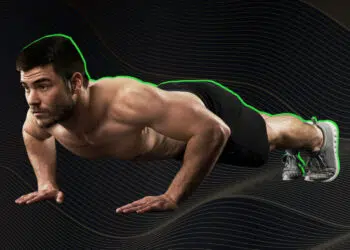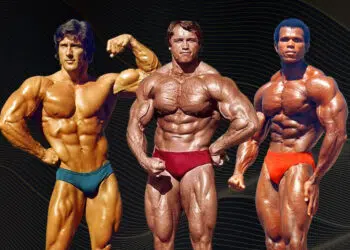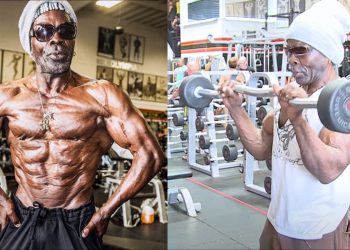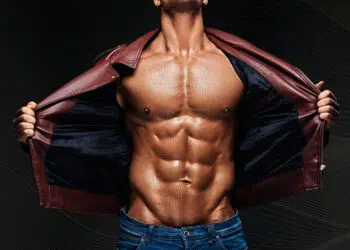When it comes to abs training, a lot of exercisers are overly fixated on working their rectus abdominis, which is the muscle on the front of your stomach. This is understandable given that, when well developed, and if you are lean enough, the rectus abdominis is the muscle that gives you a six-pack.
However, the rectus abdominus is just one of the muscles that make up your midsection. Training it in isolation is like only training your biceps when you want bigger arms or just your quadriceps when you want more muscular legs.
That means you can’t just work your abs if you want a strong, tight, toned midsection; you need to work your obliques, too.
The obliques are basically your waist muscles and, when developed, provide a great-looking frame to your rectus abdominis. They’re also crucial for stabilizing your spine.
There are plenty of exercises you can do to work your obliques, but side jackknives are one of the best.
In this article, we explain why and how to do side jackknives and reveal some of the best alternatives and variations you can use to keep your workouts varied and interesting.
Level Up Your Fitness: Join our 💪 strong community in Fitness Volt Newsletter. Get daily inspiration, expert-backed workouts, nutrition tips, the latest in strength sports, and the support you need to reach your goals. Subscribe for free!
Side Jackknife – Muscles Worked
The side jackknife works all of your core muscles. Core is the collective term for the muscles that make up your midsection. The main muscles trained during side jackknives are:

Obliques – the obliques are your waist muscles. There are two sets of obliques; internal and external. The obliques rotate and laterally flex your spine, meaning it bends your body to the side.
Rectus abdominus – located on the front of your abdomen and known as the abs for short, this muscle flexes your spine. However, when activated one side at a time, the rectus abdominus also plays a significant role in lateral flexion.
Erector spinae – the erector spinae are the muscles of your lower back. Their main job is the extension of your spine. But, like the rectus abdominis, they also assist in lateral flexion when engaged one side at a time.
Quadratus lumborum – the QL is a small muscle that runs from your lower ribs to the top of your pelvis. It works with your rectus abdominus and obliques to flex your spine laterally.
Transverse abdominus – while you can’t see your TVA, it’s still a significant muscle. Encircling your waist like a weightlifting belt, it compresses the contents of your abdomen to create intra-abdominal pressure to support your spine. It’s activated when you brace your abs.
Hip flexors – while side jackknives are undeniably a core exercise, they also involve your hip flexors as, to do this exercise, you must also lift one or both legs. The hip flexors are a group of three muscles: psoas major, iliacus, and rectus femoris.
How to Do Side Jackknives
Get more from side jackknives while keeping your risk of injury to a minimum by following these guidelines:
- Lie on your side with your body straight. Your hips and shoulders should be stacked, i.e., vertical and not leaning forward or back.
- Place your uppermost hand on your temple and push your elbow back to open your chest.
- Extend your lowermost arm out in front of you for balance.
- Contract your obliques, brace your abs, and lift your shoulders off the floor. Simultaneously lift your top leg. Hinge at the waist like a folding jackknife.
- Lie back down and repeat.
- Do the same number of reps on both sides.
You can also bend your lowermost leg and pull your knee to your elbow (easier) or lift both legs simultaneously (harder).
Side Jackknife Benefits
Not sure if side jackknives deserve a place in your core workouts? Consider these benefits and then decide!
Easy to learn – the side jackknife is a challenging yet straightforward exercise. It’s basically a side bend performed on the floor. As such, it’s suitable for beginners and exercisers looking for a simple abs and oblique workout.
No equipment required – all you need to do side jackknives is an exercise mat or folded towel to lie on. As such, it’s the ideal move for home exercisers.
Perfect for circuit training – getting into position to do side jackknives takes mere seconds. As such, it’s suitable for circuit training, HIIT, and other fast-paced workouts.
Spine-friendly – there is no compression on your spine during side jackknives. In contrast, side bends, which also work your obliques, involve compression, which could make them a little less spine-friendly for some exercisers. Side jackknives may be suitable for exercisers with mild back pain.
Relatively scalable – you can do side jackknives with a bent leg, a straight leg, or by lifting both legs together. As such, it’s scalable and suitable for beginners, intermediate, and more advanced exercisers.
Side Jackknife Drawbacks
While side jackknives are a mostly beneficial exercise, there are also a couple of drawbacks to consider:
Limited overload – even if you work up to doing side jackknives with both legs straight, you are still limited to using your body weight for resistance. As such, you may eventually outgrow this exercise and find you have to do high reps to fatigue the target muscles. This drawback is not unique to side jackknives and applies to all body weight exercises.
Uncomfortable – lying on your side on the floor may not be very comfortable. You may find your lowermost hip digs into the floor, which hurts and could even bring your set to a premature end. Overcome this problem by placing a folded exercise mat beneath your hips for extra cushioning.
Small range of motion – side jackknives involve about 20-30 degrees of lateral flexion, which is not a lot. There are other abs exercises that allow a wider range of motion, such as side bands and stability ball crunches.
Level Up Your Fitness: Join our 💪 strong community in Fitness Volt Newsletter. Get daily inspiration, expert-backed workouts, nutrition tips, the latest in strength sports, and the support you need to reach your goals. Subscribe for free!
10 Side Jackknife Alternatives and Variations
Side jackknives are a highly effective core exercise, but that doesn’t mean you need to do them all the time. There are plenty of variations and alternatives you can use to keep your workouts productive and interesting:
1. Side Plank
Where side jackknives are a dynamic exercise, side planks are isometric, which means they don’t involve any movement. If your obliques are weak and you’re struggling to do side jackknives correctly, spend a few weeks doing side planks to build the necessary strength.
How to do it:
- Lie on the floor on your side and rest on your forearm with your elbow directly under your shoulders.
- With your legs and hips straight, lift your body, so your weight is supported on your arm and the sides of your feet only.
- Hold this position (but never your breath!) for the prescribed duration.
- Lower your hips down to the floor, rollover, and repeat on the opposite side.
2. Lying Side Hip Raise
This exercise is a more dynamic version of side planks. When doing lying side hip raises, you adopt the side plank position but then purposely lower your hips to the floor and then lift them back up, so your body is straight. Some people find this exercise more comfortable than side jackknives.
Learn how to do lying side hip raises here.
3. Cable Side Crunch
One of the main drawbacks of side jackknives is that you are limited to using your body weight for resistance. As such, you may eventually become too strong for the exercise, and you’ll have to do time-consuming high rep sets to fatigue your muscles.
Cable side bends work the same muscles as side jackknives, but because you can increase the weight, you can modify the exercise as you get stronger. Plus, working with cables means you can keep constant tension on your lateral core.
Find out how to do this exercise here.
4. Dumbbell Side Bend
The dumbbell side bend is a pretty old-school core exercise. Some people even doing it because they believe it’ll make their waist thicker. The truth is that the obliques have very little potential for growing thicker, so this is nothing to worry about.
However, it’s critical that you only use one weight for this exercise. Some exercisers make the mistake of holding a dumbbell in both hands, which turns your body into a sort of seesaw and takes most of the stress off the target muscles. Instead, just use one dumbbell for a far more effective workout.
Learn how to do dumbbell side bends here. You can also do side bends using a low cable machine.
5. Single-Arm Farmer’s Walk
We’re the first to admit that the single-arm farmer’s walk looks nothing like the side jackknife exercise. And yet, it works many of the same muscles. Carrying a heavy object in one hand forces you to use your obliques and abs to hold your torso upright, which is why this is such an excellent exercise for strengthening your midsection. As an added benefit, single-arm farmer’s walks also improve your grip and burn plenty of calories, too.
How to do it:
- Place a single dumbbell on the floor and then stand next to it. Squat down and grab it tightly, and then deadlift it up, so you are stood perfectly upright. Brace your core hard.
- Take a walk around your training area, continuing until you feel your grip starting to fail. Lower the weight to the floor, swap hands, and repeat.
- You can also do this exercise with a kettlebell or, for an even greater challenge, a barbell. However, you’ll have to make sure you grip it precisely in the middle.
Alternatively, you can hold your weight above your head. This is called a single-arm farmer’s walk and helps develop shoulder stability as you work your obliques.
6. Stability Ball Side Crunch
Another drawback of side jackknives is that your movement is limited by the floor, so you can’t take your obliques through their full range of motion. With stability ball side crunches, you can bend further to the side, which leads to a more challenging workout. Also, as the ball wobbles, you’ll have to work harder to stabilize your midsection, further increasing core engagement.
How to do it:
- Lie on your side on a stability ball. The ball should be under your hips. Place one foot in front of the other and brace them against a wall for balance. Cross your arms over your chest.
- Keeping your hips and shoulders square, lean sideways, and wrap your upper body around the ball.
- Lift your shoulders back up so your spine is flexed upward, and then repeat.
- Swap sides and do the same number of reps.
7. Oblique Crunches
Oblique crunches are a lot like side jackknives. However, you don’t move your legs and must focus solely on lifting your upper body. If you are finding it hard to coordinate moving your legs and upper body simultaneously, you’ll probably appreciate the simplicity of this exercise.
How to do it:
- Lie on your left side with your hips square and your legs bent. Place your left hand on the right side of your waist to provide feedback from your working muscles. Put your right hand on the side of your head.
- Use your uppermost obliques to flex your torso and draw your right shoulder down toward your hip. Move slowly and deliberately, contracting your obliques as hard as you can.
- Pause at the top of each rep for 2-3 seconds, lie back down, and repeat.
- Roll over and do the same number of reps on the opposite side.
8. Side Plank Leg Lift
Side planks provide your obliques with a good workout. But, like most bodyweight abs exercises, all too soon, they will lose some of their effect, and you’ll need to do them for longer and longer. This side plank variation involves a leg raise which makes them more challenging. You can also do this exercise for reps instead of a predetermined time.
How to do it:
- Lie on your side with your body straight and resting on your bent arm. With your legs together, raise your hips up so your weight is supported on your lowermost foot and arm only. Brace your abs.
- Without raising or lowering your hips, lift your uppermost leg until your foot is toughly level with your shoulder.
- Lower your leg and repeat.
- Swap sides and do the same number of reps with the other leg.
9. Suitcase Deadlift
This is another exercise that looks nothing like side jackknives but still works many of the same muscles. The name comes from how this exercise makes you look like you are bending down to pick up a bag or suitcase.
It involves bracing your abs and using your obliques to maintain an upright torso while doing single-arm deadlifts. It’s a very functional exercise that’s ideal for building full-body strength and stability.
How to do it:
- Set up your barbell so it’s roughly mid-shin height. You can also use a single dumbbell or a kettlebell. Stand sideways to your weight.
- Without leaning sideways, feet shoulder-width apart, squat down, and grab the weight with your nearest hand. Drop your hips, lift your chest, brace your core, and look straight ahead.
- Drive your feet into the floor and stand up, ensuring you do not lean toward or away from the weight.
- Lower the weight back to the floor and repeat.
- Rest a moment and then do the same number of reps on the opposite side.
10. Shovel Lift
The shovel lift is one of the most unusual core exercises around. As the name suggests, it replicates using a shovel to dig a ditch. The shovel lift works your obliques, rectus abdominus, and all the other muscles involved during side jackknives. However, your arms and legs will get a great workout too.
How to do it:
- Leaving one end of your bar on the floor, bend down and grab the other end with a mixed grip, hands a little wider than shoulder-width apart. The closer to the end of the bar you stand, the harder this exercise becomes, so position your hands accordingly.
- Stand up so that the bar is angled down toward the floor. Bend your knees slightly and brace your core tight. Do not round your lower back.
- Using your entire body, lift the weighted end of the bar up until it is at or above head height. Imagine you are digging dirt and trying to lift it onto a raised truck bed.
- Lower the end of the bar back to the floor and repeat. Don’t bounce it, as that will just damage the bar.
- On completion of your set, rest a moment and then repeat but, this time, stand on the opposite side of your bar and reverse your hand position to ensure you train both sides of your body equally.
Side Jackknife Guide – Wrapping Up
If you want a strong, great-looking midsection, you need to pay as much attention to your obliques as you do your rectus abdominis. While the rectus abdominus is usually the most visible of the core muscles, the obliques should be close behind. They form your waist and create a pleasing frame around your abs, really highlighting your tight, lean midsection.
The obliques are also essential muscles for lumbar stability and function. They’re strongly involved in all rotational movements, such as throwing and punching.
Side jackknives are a convenient way to train your obliques. With no equipment required, you can do this exercise anywhere and anytime. There are also variations for beginner, intermediate, and advanced exercisers.
So, add side jackknives to your core workouts and stop neglecting your obliques!
Interested in measuring your progress? Check out our strength standards for Deadlift, Side Crunch, Squat, and more.








